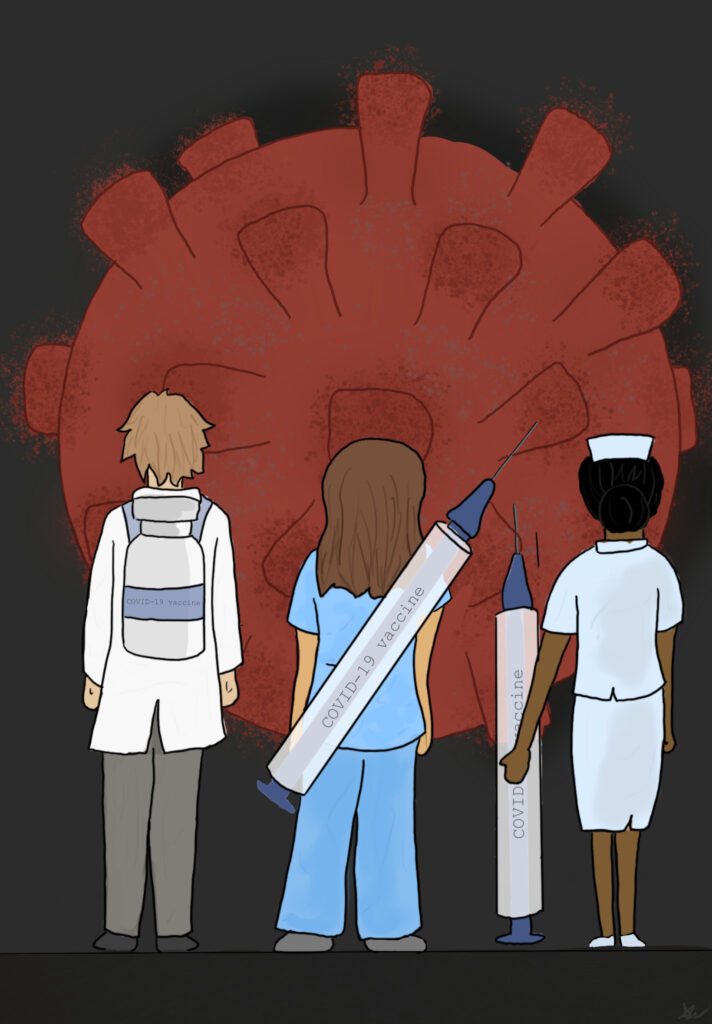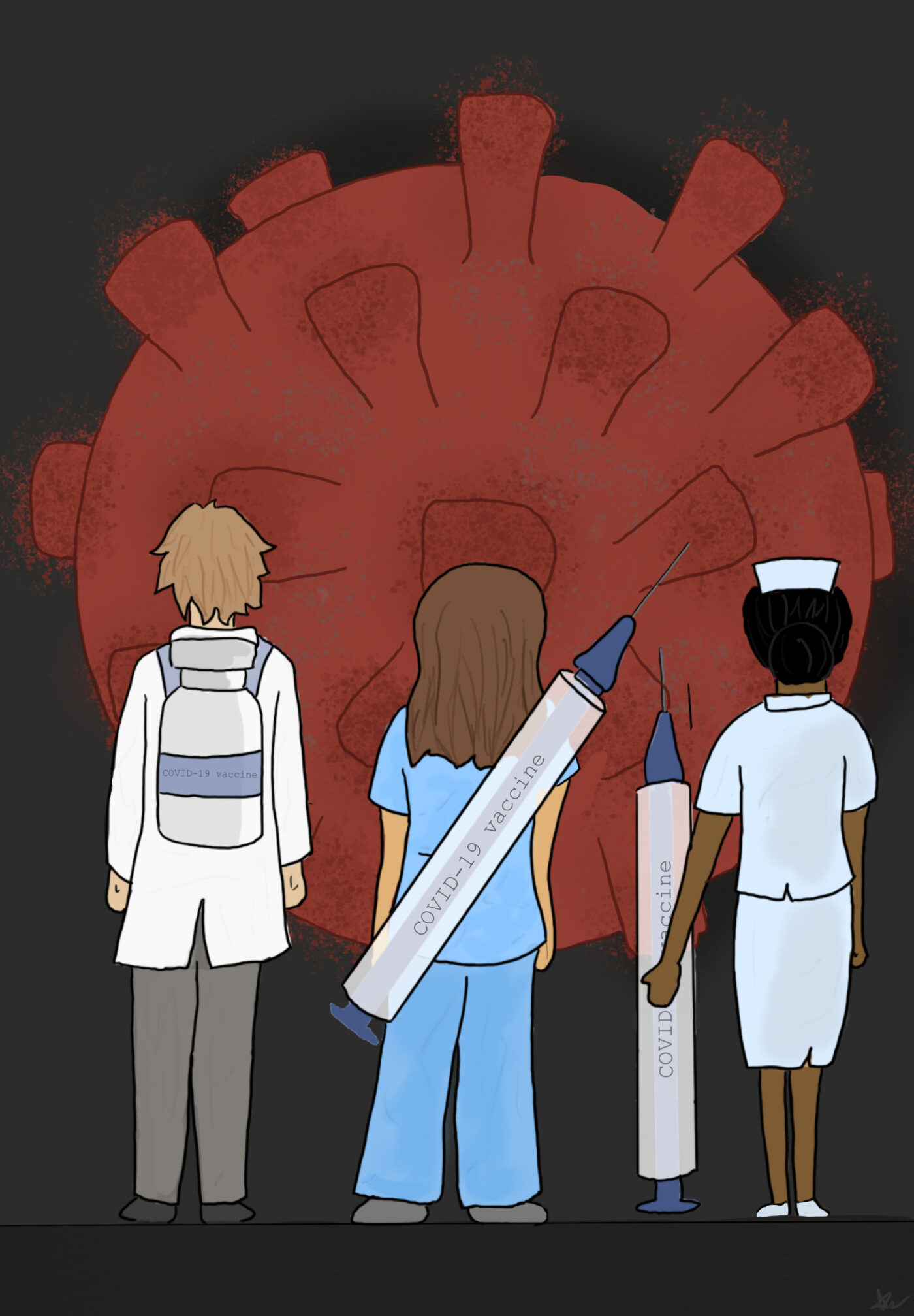
“The cure to COVID-19 isn’t the beginning of the end, but the end of the beginning.”
To vaccinate or not to vaccinate? The heated topic, laughed at by some and furiously defended by others, has taken the forefront owing to the pandemic. During the many months of fear, anxiety and uncertainty that the COVID pandemic put us through, for most, a vaccine felt like the only cure to the never-ending monotony of staying at home.
The vaccine can ease the burden on healthcare services, whose limits are being stretched and tested to extremes. Being vaccinated can reduce the severity of symptoms experienced, leading to a better quality of life. Most importantly, it can cut down on the scarily-increasing death toll due to the virus, which has been creating ripples of destruction in its wake.
But now that it’s finally here, a new section of society feels that this vaccine is not for the better; on the contrary, it will make lives even more complicated. Dubbed as ‘Anti-Vaxxers’, they’re a minority as of now, but steadily growing in number.
As illogical as their statement may sound at first glance, delving deeper into their arguments would perhaps lead one to understand the root of their fear.
There are factors to be considered while weighing the vaccine’s effectiveness. The adaptive method used for testing—the expedited and overlapping vaccine trials—contrasts with the decade-long process of slower, spaced-out trials that are the norm for vaccine development. There is some undeniable risk that comes with such hurried development.
It’s essential to keep in mind that not all vaccines are created to prevent infection; those made by Moderna and Pfizer aim to prevent just symptoms of COVID-19. In other words, they will protect the inoculated individual from falling sick, but they might still be carrying the virus and can transmit it to others; it just won’t affect them.
The question remains—why are thousands of people critical of what should have been a celebrated breakthrough in medicine?
After the announcement of the vaccine’s rollout, many were euphoric, celebrating the ‘light at the end of the tunnel’. It may lead to people overlooking precautionary measures such as social distancing and wearing masks. Clickbait headlines talking about how “a cure is finally here and we can all live normally again”, causes risk perception, a phenomenon where ill-informed people perceive that vaccination makes them virtually immune to getting infected.
Another central point to be considered is the unpredictability of the coronavirus itself. The mutated strain of COVID-19 originating from the UK and a few other countries is said to be 70% more contagious with no increase in lethality, as far as preliminary studies can tell. The vaccine is effective against the new strain, but how long until there’s a strain that renders the vaccines obsolete?
The vaccines currently in the market have been tested for two doses to prove their effectiveness. That might enable the virus to mutate, immunise itself, and develop resistance to the vaccine rendering it ineffective.
The efficacy of the forerunner vaccines, Pfizer-BioNTech and Moderna, was an astounding 95%; even the vaccines that have been in use for years have currently not got numbers this high. However, this is only a result of the comparatively smaller pool of tested candidates. They are expected to go lower as more people are vaccinated en masse.
Another factor contributing to the high efficacy is that trial margins for vaccines have been stretched as far as possible (the trials are progressed upon touching the minimum requirement) without compromising on safety and other protocols. The stage two trials of vaccines tested against 50,000 people, but mass vaccination covers millions of people. Therefore, until mass vaccination data is interpreted, we lack the information needed to correctly predict patterns and repercussions.
According to claims by major vaccine candidates, only half of the needed doses for mass vaccination would be produced. Thus, a large population unvaccinated could relapse and even mutate, making it a ticking time bomb.
Many believe the vaccine industry is virtually monopolised by ‘big pharma’ companies due to the complexity of its creation. People fear that could involve compromises, corners cut, and red tape, potentially leading to significant issues in the long run. The vaccine’s urgency led to coalitions between these well-funded companies and governments, research societies and universities, keeping these corporations in check.
One of the concerns is that a lapse in quality control, manufacturing, or any step in the expedited process will lead to disasters like the Cutter Incident. In 1955, thousands were infected by a live virus injection, mistaken for an inactivated polio vaccine. Anti-vaxxers may back their stance by citing the disaster and have the public lose hope. Adding to the hysteria, many world leaders like Donald Trump, and academicians have vocally spoken about such issues stating factual inaccuracies leading to a loss of trust among the general public.
Many refer to the example of UK professor Andrew Wakefield who in 1998 claimed in his studies that there was a link between the measles vaccine and autism. Hundreds of thousands had taken the vaccine before the World Health Organization (WHO) discredited his research. They fear that the world’s governments might be pulling off ‘a Wakefield’ on a global scale.
Such hysteria and resistance to getting vaccinated fatally wound the hopes of the pandemic receding. Global polling indexes showed only 36% of adults would take a vaccine when available. Since the minimum percentage to overrun the pandemic is 70%, the numbers fall miserably short. Thus, getting vaccinated may not even ensure the end of the pandemic.
Potential risks with the mass vaccine roll-out worldwide
Capitalising on the high demand and desperation for the vaccine, scammers are creating almost legitimate lookalikes of websites spewing misinformation and incorporating links with malware.
However, the foremost concern is the sale of fake vaccines either on these sites or the dark web. It not only poses a security threat but also that of safety, as the contents of the vaccine could be highly dangerous to consume. A health mishap due to any vaccine, fake or otherwise, would further seal an anti-vaxxers’ beliefs. As tiresome as it may sound, checking for verification of sources and receiving vaccines only from a professional’s hands is essential.
The amount of time for which the vaccines would grant immunity from the virus remains an important question, as they simply haven’t been around long enough to examine.
The vaccines created by the corporations are all different; some require mean refrigeration of -80 degrees celsius while the others can be stored in basic sub-zero temperatures. It is difficult to store and transport as the vaccines risk losing their effectiveness at higher temperatures.
But, it’s not an opportunity to go ‘doom-scrolling’ or subject yourself to fear and anxiety. Here are a few reasons why.
According to research, vaccines don’t change existing genetic material to work; they do not go inside our cells’ nucleus where the DNA is stored. The mRNA simply acts as the template for the necessary instructions required by our body to produce the specific antibodies against CoVID-19. The body will degrade and dispose of the mRNA naturally once it has done so.
Long-term effects can be determined in a span of months; vaccines produced in the past haven’t caused problems five years down the line. This fact should offer some reassurance to those who are sceptical only about the long-term effects of COVID vaccines.
Most vaccines administered until date have produced side effects in only a negligible percentage of the vaccinated population. These include mild fevers, temporary soreness around the injection area, nausea and diarrhoea—all of which are considered regular side effects and do not raise any red flags.
People who are immunocompromised, have allergic reactions to the virus, are pregnant or lactating, are exempt from the vaccine. To ensure that there isn’t an adverse immediate or late reaction to the vaccine, those vaccinated are made to wait for a short amount of time and are monitored before being given the green light.
It has to be noted that medicine has come a long way since the discovery of vaccinations. The technology to revolutionise the creation and delivery of modern vaccines has also advanced. There is years’ worth of research done on coronaviruses (specifically, the coronaviridae family). This research has acted as a basic template off of which the vaccines are developed. Zika virus is an example, where development was built upon prior successful studies on similar flaviviruses, i.e. the family of viruses under which the Zica virus comes.
Not all the COVID-19 vaccines are mRNA-based. Pfizer-BioNTech’s and Moderna’s vaccines are, but their prominence in the media creates a false assumption that this is the only approach taken by vaccine developers. Many companies have taken the tried-and-tested route of using inactivated vaccines, which merely introduce a weakened and sterile version of the virus to a person’s system to generate an immune response.
The problem of unpredictability with this virus also comes in favour of the vaccine. Every person’s response to the virus is different; it is safer to get inoculated against the virus and face little to no complications later on.
While there are grey areas for the production, efficiency, and delivery of the vaccines for COVID-19, one must understand its impact globally. The vaccine is the closest the world has got to a cure, at least in the near future, and the most significant opportunity to establish a new normal.
Herd immunity is the best chance for humankind to bounce back and get the world up and running. The COVID-19 pandemic has impacted billions of people, and trust forms the basis of operations on a global scale. Mutual trust regarding activities that make the world a better place is no longer about worldly gain. Still, it represents a service to ensure continual human existence on this planet.
Thus, vaccines are the lion’s share of steps to induce normalcy into the world today. It is imperative for everyone to accept this step and ensure that they play their crucial part in the battle against this deadly virus.
Sources: CDC.gov, dw.com, fredhutch.org, The BMJ Opinion, LiveMint, CNBC
Written by Aditya Arun Iyer and Ishita Gaur for MTTN
Edited by Tulika Somani for MTTN
Featured Image by R.S. Aruna for MTTN

Leave a Reply
You must be logged in to post a comment.